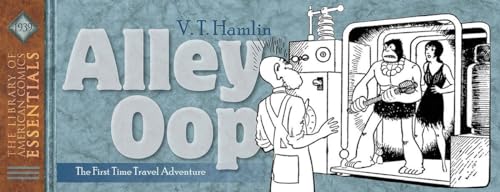LOAC Essentials 4: Alley Oop
“This is a delightful mixture of comedy, time travel, history and adventure, one fit for fans of all ages. Alley Oop works so well . . . A strip ripe for discovery by a new generation.”
In a moment from Earth’s very distant pass, a time when dinosaurs and men walked the earth together, caveman Alley Oop and his cave girl companion Ooola find themselves cornered in a prehistoric forest.
The king of Moo has trapped them and is planning to either kill them or at the very least, cause some serious harm. It seems that when Alley Oop found out that the king of Moo stole an egg from Oop’s pet dinosaur Dinny, Oop felt compelled to confront the king and in the process may have clobbered him over the head with his club. And the king demands revenge.
Mere seconds before the king of Moo is set to capture Alley and Ooola, the two are swept through the barriers of time and space to the future. Thus begins one of the grandest adventures in the history of newspaper comics.
Alley Oop is a classic graphic novel style of story that fans of Dr. Who, the Sci-Fi channel or the work of Ray Bradbury, H. G. Wells, or Philip K. Dick will love the minute they start to read it.
The strip debuted in 1932 and in its first few years was centered on the mythical, prehistoric community called “Moo.” Driven by the fantastical idea that dinosaurs and men once roamed the earth together, the strip showcased a community of folks with problems and conflicts that were remarkably similar to those found in modern times.
As the first few years passed the creator, writer and artist V. T. Hamlin, began to look for ways to expand the strip. Like the best of writers he decided to follow the golden rule of “write what you know about.”
As author and historian Michael H. Price tells us in his introduction, Mr. Hamlin loved sci-fi and history. So he decided to combine the two inside Alley Oop.
Introducing a time machine into a daily comic strip was a revelation. Although sci-fi was seen in Buck Rogers and Flash Gordon, as genre science fiction was essentially providence of pulp paperbacks and dime novels. Mr. Hamlin brought time travel to a very wide audience. And made it real.
The first story line in Alley Oop’s time traveling saga (as featured in this volume) takes readers from the prehistoric era into the 1930s and ultimately back to ancient Greece.
Just in time for Alley Oop, Ooola and their new friends to take part in the Trojan War, accompany Ulysses on the Odyssey, meet Hercules, and drive a station wagon across ancient Greece.
Readers loved the idea that a caveman could cavort across the centuries with such abandon. No matter what happened Alley Oop was always tougher than everyone else, held to a strong code of honor and in often trouble with Ooola.
The concept proved to be so popular that adventures of Alley and his friends are still in print in newspapers across America today.
Earlier volumes in The Library of American Comics Essentials reprint series have featured such classic strips such as Polly and her Pals, The Gumps, and Baron Bean. Each one focused on a specific, historically important period in the strip’s continuity. This volume, number four in the series, isolates the pivotal year in which Mr. Hamlin took the strip out of the prehistoric and placed it into the realm of the infinite.
Reprinting every daily strip as they originally appeared in newspapers from March 1939 until March 1940 the story covers the effortless way that Mr. Hamlin introduced the idea of time travel to his readers.
The first few weeks focus on the strip’s original premise of life in the prehistoric era. Within a month over eight years of continuity and familiarity experience a seismic shift as Oop and Ooola are both swept into the future.
As the story moves between the past and the present over the next 11 months of stories Mr. Hamlin’s love of history shines. He gives a modern sensibility to his portrayal of Helena of Troy, Hercules, and other figures from the past.
Just as he had when the strip was set in the prehistoric era, Mr. Hamlin made the strip shine by writing real, flawed and very human characters—albeit with a generous touch of vaudeville, good puns and slapstick humor.
Every single panel shows us that Mr. Hamlin had not only a rare gift for working in sequential art, but a deep love for what he created. He deals in time and understands it on multiple levels. As detailed as it is, nothing he ever drew feels rushed.
Where most artists would show the front page of a newspaper and draw simple, curvy lines, he creates a readable front page that furthers the action of the story.
When he draws a Trojan Horse, the dimensions impress upon the reader the actual size that the gift in comparison to the size of a human. As Ulysses’ ship begins to take on water, you can feel the bulk and heft of the vessel. Later when the ship circles the outer edges of the whirlpool Charybdis, the danger is intimidating.
Thrown overboard Alley has to battle underwater. The shading in the darkness of the scenes not only serves the scary nature of the unknown but adds a feeling of thick, physical pressure to the scenes.
This is a delightful mixture of comedy, time travel, history and adventure, one fit for fans of all ages. Alley Oop works so well because Mr. Hamlin had a gift similar to what E. C. Segar brought to Popeye, no matter how absurd the situation, no matter how crazy everything we see seems, the world we see is believable because the people are.
A strip ripe for discovery by a new generation.
